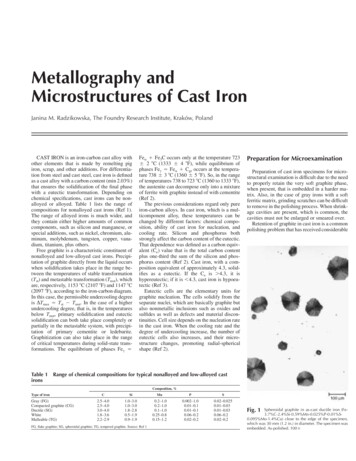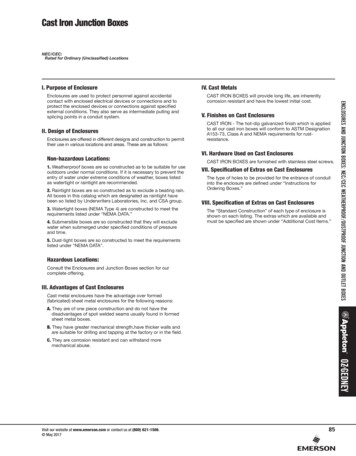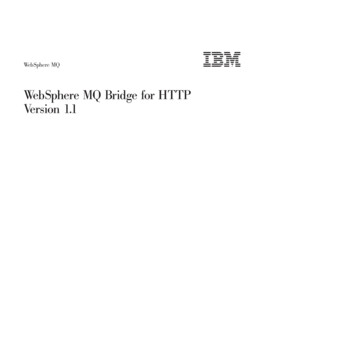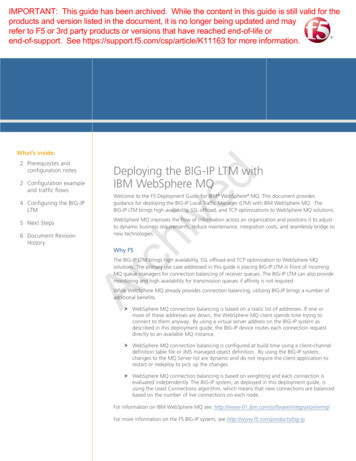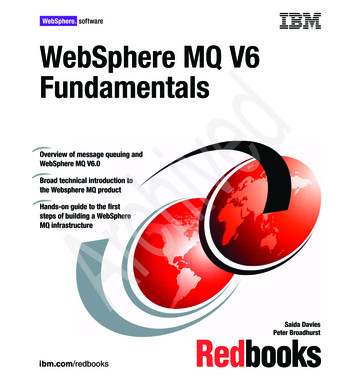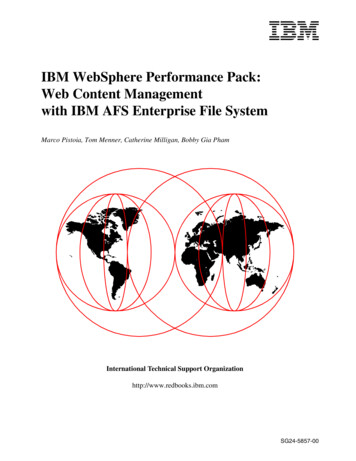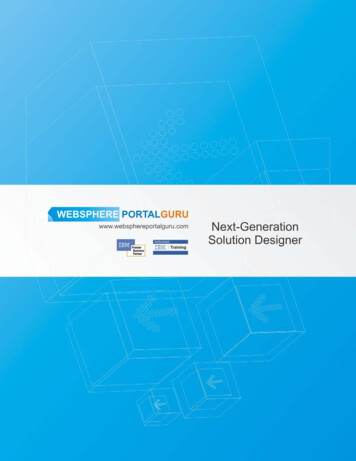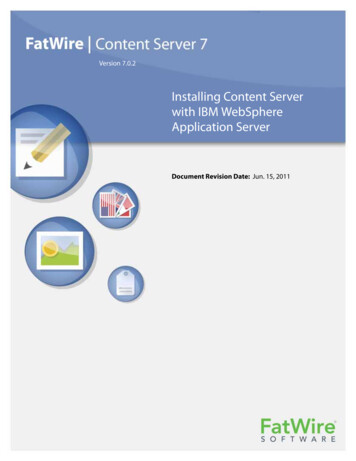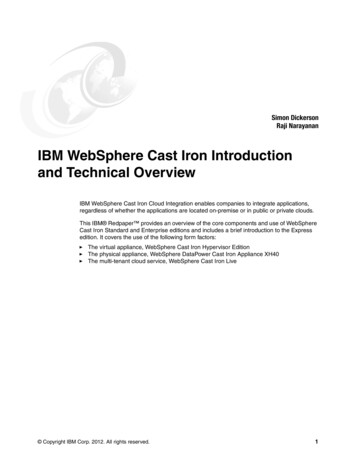
Transcription
Simon DickersonRaji NarayananIBM WebSphere Cast Iron Introductionand Technical OverviewIBM WebSphere Cast Iron Cloud Integration enables companies to integrate applications,regardless of whether the applications are located on-premise or in public or private clouds.This IBM Redpaper provides an overview of the core components and use of WebSphereCast Iron Standard and Enterprise editions and includes a brief introduction to the Expressedition. It covers the use of the following form factors: The virtual appliance, WebSphere Cast Iron Hypervisor Edition The physical appliance, WebSphere DataPower Cast Iron Appliance XH40 The multi-tenant cloud service, WebSphere Cast Iron Live Copyright IBM Corp. 2012. All rights reserved.1
Integrating cloud applicationsCloud computing has become a business evolution that is impacting all facets of businesstoday, including sales, marketing, human capital management, supply chain, finance,manufacturing, quoting, ordering, service, support, email, and so on. As each of thesefunctions move to the cloud they require migration and integration. Additionally, each vendorproviding a cloud solution creates their own interface to the application. This fact creates achallenge in IT organizations in companies of all sizes and all locations globally as theyattempt to understand and then manage these unique application interfaces and integrateapplications from cloud to cloud and cloud to on premise. It is for these reasons that IBMCast Iron is an invaluable solution to a modern IT infrastructureCloud computing can provide companies with the following capabilities to meet businessneeds: Flexibility in working practices, such as working from home, the office, or with mobilecomputing, which creates the need to access data and files from anywhere at any time Easy implementation of applications that are offered as a software as a service (SaaS)and that can be configured and running in a matter of days Low cost solutions that can be paid for incrementally A reduction in the IT resource that is required for the maintenance of servers andinfrastructure A reduction of impact from software upgrades and maintenanceHowever, the adoption of SaaS applications can mean that additional silos of information arecreated, which can lead to further disparate sources of information. These disparate sourcescreate a challenge in that there is a hybrid architecture that includes on-premise solutions andthe new SaaS applications. Integrating these applications and data can be key to theefficiency of the business. Integration can ensure that business users have access to theinformation that they require with the least possible friction, thus maximizing productivity andimproving customer interaction.Integration can be beneficial in the following situations: Migrating data to new SaaS applications Providing a single view of customer information in cloud and on-premise applications, forexample a cloud-based CRM system and an on-premise Enterprise Resource Planning(ERP) system Using information from cloud marketing automation in e-commerce solutions Providing connectivity between private cloud systems and business partner solutionsAn integration solution must bridge the gap between the on-premise existing systems andnew cloud applications, platform, and infrastructure, providing a rapid and easy-to-usemethod of setting up the integrations.WebSphere Cast Iron provides a solution that meets the challenge of integrating cloudapplications with on-premise systems, cloud applications-to-cloud applications, andon-premise to on-premise applications, as illustrated in Figure 1 on page 3. The WebSphereCast Iron environment focuses on the business requirements, the applications, and thebusiness user requirements. It removes the daunting complexity of integration.2IBM WebSphere Cast Iron: Technical Overview
Cloud Applications and grownApplicationsFigure 1 Cast Iron integrationExample use casesWebSphere Cast Iron was beneficial in the following typical use cases: Exposing ERP information to sales agentsA company needed to make sales order information that was stored in multiple ERPsystems available to sales agents who used a SaaS-based CRM system. Integrating theERP information with the CRM system provides the agents visibility to the necessaryinformation and avoids the agents having to sign on to multiple systems. The companyhad only a small IT department, with no substantial development capability, so they need atool that business analysts can use.The initial project involved using WebSphere Cast Iron to create three orchestrations thattook less than two weeks to develop. The orchestrations provided real-time integration ofthe ERP information into the CRM system. Over time, the integration capabilities wereexpanded. There are now over 150 orchestrations connecting a multitude of systems thatare running both in batch and on request. Integrating separate insurance policy systemsAn insurance company has multiple systems that are used to manage new business.Having one system that provides quotes for policies and another system that is used toadminister policies occasionally resulted in duplicate data entry and as a result, generatederror conditions. In addition, many of the workflows involved in bringing in new businessare manual, and vendors must provide documents in multiple formats.The company used WebSphere Cast Iron to provide bidirectional integration between thetwo systems. Policy quote information is integrated into the administrative system and viceversa, making it necessary to enter data only one time and ensuring the integrity of thedata in both systems. Integrating data through key business systems ensured that filesIBM WebSphere Cast Iron Introduction and Technical Overview3
were routed correctly and that workflow was not interrupted if a user is unavailable.Vendors must provide data only in one format with the integration solution making the dataavailable to the systems where it is needed in the proper format. Finally, the integrationsolution eliminates errors that were introduced because of duplicate data entry. Synchronizing e-commerce systems and linking to the SaaS CRM application to provide asingle view of customersA commercial enterprise has two e-commerce systems that are populated with customerand order data that is currently not synchronized. The enterprise also has a CRMapplication where customer data is kept and a fulfilment system with inventory and productdata. The enterprise used WebSphere Cast Iron to integrate the data in these systems toprovide a more cohesive view of customer data.The initial implementation included the following orchestrations that provided the initialpopulation of data throughout the systems and the synchronization of information betweensystems:– Data providing a single view of the customer (SVC) was populated into the SaaS CRMsystem from the enterprise’s existing systems using a web services integration.– An orchestration with a short polling interval pushes account, order, inventory, andproduct information to the SVC from the e-commerce and fulfilment systems, ensuringthat the customer service staff has the most current information.– A nightly refresh of all stock keeping units (SKUs) in the e-commerce system occursbased on information from the fulfillment system. The orchestration uses secure filetransfer to perform the refresh.– Synchronization of customer records between the two e-commerce systems occurs ona regular basis, ensuring that when customers sign in to a system their data isavailable to them.The WebSphere Cast Iron approach to integrating applicationsWebSphere Cast Iron provides an approach to integrating applications that does not requireany programming knowledge. You can build integration flows in WebSphere Cast Iron Studio(referred to in this paper as Studio), which is a graphical development environment that isinstalled to a personal computer (PC). With Studio, you create an integration project thatcontains one or more orchestrations. Each orchestration is built with a number of activitiesthat define the flow of data. You can define the details of an activity from the configurationpanes within Studio.A project contains all of the assets that are required for the orchestrations to run, includingany file schemas, WSDL files, and functions. The project also defines connectivity to thesources of data, the endpoints. Cast Iron contains many built-in connectors to applications(for example SAP), databases, and web services that make connecting to these endpointsstraightforward.4IBM WebSphere Cast Iron: Technical Overview
Figure 2 outlines the Cast Iron approach. Within Studio, there is a simulated runtimeenvironment to enable unit testing of the orchestrations with visibility of all data at all points.After you test the project, you can publish the project to the run time, where you can thenmanage and monitor the project. A browser-based interface, the Web Management Console(WMC), provides the capability to manage all functions on the run time.Cast Iron Live: Cast Iron Live provides the same Studio development environment andruntime functionality as a physical or virtual Integration Appliance but through acloud-based service. In Cast Iron Live, you publish a project to an environment, forexample development, test, and production. The environment contains the functions of anon-premise Integration Appliance.Cast IronCommunity TIPsCloud Applications anddatabases(public/private)Cloud Appl ications anddatabas es(publi c/pri vate)Publication ofprojects to production Int egrati onAppli anceInt egrati onApplianceCast Iron StudioManagement ofintegrationappliance throughweb browserAppl ications/Endpoi ntsAppl ications/Endpoi ntsFigure 2 Cast Iron approach to developing integrationsAs with any tool, there are preferred practices to implement designs. When processing largeamounts of data, a poor design can mean that the integration takes an extraordinary amountof time or that it simply does not work. Each endpoint is different in its requirements, and anyintegration flow must use the characteristics of the endpoint to its best advantage, for exampleprocessing batches of data to optimize the speed of transactions.Cast Iron also provides Template Integration Projects (TIPs) that encapsulate a specificintegration use case between specific endpoints and that include preferred practices. You candownload these TIPs from the Cast Iron community and modify to fit your precise needs.Cast Iron Express uses a unique approach to the design and build of the integrationworkflows and is introduced in “Express edition” on page 23.IBM WebSphere Cast Iron Introduction and Technical Overview5
Architecture overviewCast Iron provides the following models of implementation: An appliance model where the appliance can be either physical hardware or a virtualmachine and where the Integration Appliance is installed on-premise, behind the firewall A SaaS model (Cast Iron Live)Each of the three form factors (physical, virtual, or Cast Iron Live) allows for cloud-to-cloud,cloud to on premise and on premise to on premise integration. Each form factor allows for realtime, near real time, and batch integrations.This section introduces the components of a Cast Iron implementation, differentiatingbetween the on-premise Integration Appliance and the cloud model (Cast Iron Live).On-premise Integration ApplianceAn on-premise appliance normally resides behind the firewall and not within a DMZ. For thedevelopment, test, and production life cycles, the runtime environments are typicallyseparated and each has its own Integration Appliance that accesses the endpoints that arenecessary for that environment. Figure 2 on page 5 outlines the approach for using anon-premise Integration Appliance.You have full control of projects and their orchestrations on the appliance through the WMC.The orchestrations are started through a mechanism that is defined by an activity in theorchestration. These activities include scheduling, polling, or waiting for an incoming request,such as an HTTP Receive Request. Each orchestration must include at least one of thesestarter activities.The Integration Appliance requires connectivity to the endpoints that are required by theorchestration. Data flows through the Integration Appliance and is stored internally as XMLvariables. The Integration Appliance allows you to control the logging for each orchestration.Cast Iron LiveThe multi-tenant Cast Iron Live service includes the following key components that allow youto design, run, and manage integrations, all in the cloud: A clustered runtime engine that runs the integrations and that has built-in fault-toleranceand recovery mechanisms A multi-tenant highly-available system to store the designed integrations A load-balancer to intelligently manage the loads throughout the various runtime engines Highly-available file-systems to store and manage logs that are related to the integrationsThe design environment, referred to in Cast Iron Live as Designer, provides the same designcapabilities and user interface as Studio does for the on-premise Integration Appliance.You can access the Cast Iron Live interface from a web browser, as shown in Figure 3.Figure 3 Cast Iron Live tabs for life cycle environments6IBM WebSphere Cast Iron: Technical Overview
You access the runtime environments through the Development, Production, and Test tabs.You can create projects in the Create tab and later change projects using the Modify tab.The Modify tab, Figure 4, shows all projects that you are allowed to view.Figure 4 Cast Iron Live Modify tab showing a list of projectsEach project has the following actions, as shown in Figure 5, which are initiated by clicking anicon: Edit Project ()Publish ()Delete ( )Create New Version()Figure 5 Cast Iron Live project Actions iconsTo edit a project, select Edit Project, and then select Edit Project in Designer. The Studiodevelopment environment opens with the same functionality that the on-premise installationhas. You can then publish the project to one of the runtime environments by selectingPublish.When using Studio in Cast Iron Live, development is the same as for an installation on thelocal PC. Studio in Cast Iron Live has access to the same endpoints that the PC has accessto. When publishing to a runtime environment, the orchestration is run in the Cast Iron Livecloud.Figure 6 on page 8 illustrates the Cast Iron Live process. A developer accesses Cast Iron Livethrough a web browser, creates projects, and develops these projects with Studio (which runsin a Java runtime environment on the PC). When complete, the developer publishes theproject to a test environment. After testing, the projects are published to a productionIBM WebSphere Cast Iron Introduction and Technical Overview7
environment. You can also manage the environment, the projects, logs, and othercomponents through a web browser. If you connect to applications or endpoints behind afirewall, the Secure Connector is required, as described in the following section.Cloud Applications anddatabases(public/private)Cast Iron SecureConnector (Test)Project developmentand unit test in CastIron StudioSecure Connector(Production)Web browsermanagement ofproject deploymentand Cast Iron duction)Figure 6 Cast Iron Live architectureSecure ConnectorThe Cast Iron Live Secure Connector allows orchestrations in Cast Iron Live to connect toendpoints behind a firewall. A separate Secure Connector is configured for each environmentand is installed to a computer that is running the Windows or Linux operating systems behindthe firewall.The Secure Connector includes the following security features: The Secure Connector always initiates communication with Cast Iron Live and thatcommunication is validated before the Secure Connector attempts further processing. Communication between the Secure Connector and Cast Iron Live is based on thestandard SSL 128-bit encryption over HTTPS through port 443. When the SecureConnector starts, it undergoes the SSL/TLS handshake, authenticates through standardX.509 certificates, and establishes a TLS-encrypted tunnel if all connections aresuccessful. When the TLS connection is established successfully, the Secure Connector sends arequest to Cast Iron Live for authentication. Based on information that is provided by theSecure Connector, including a private key, Cast Iron Live ensures that only the correctSecure Connector is granted access to a particular environment of a tenant.8IBM WebSphere Cast Iron: Technical Overview
Data transmission and requests that are inbound to the Secure Connector from Cast IronLive are limited to the available set of endpoint connectors that are provided by Cast Iron.Users must explicitly specify address and authentication information from each endpoint towhich they are connecting. Local scripts or executables cannot be run directly through the Secure Connector. The Cast Iron Secure Connector can have the network or IPs, that it can access internally,restricted.Further security information is available in the IBM white paper, WebSphere Cast Iron LiveSecurity, which you can download lias?infotype SA&subtype WH&htmlfid WSW14139USENDeveloping integrationsIntegration workflows, or orchestrations, are contained within a project in Studio. When theproject is complete, you publish it to the runtime environment.Studio includes the following capabilities: The ability to design integrations from scratch using a drag-and-drop design palette A Template Integration Projects repository that allows you to reuse existing orchestrations Built-in connectivity to many cloud and on-premise applications Built-in transformation capabilities to improve data quality before the data reaches thetarget system Built-in functions to transform data from source format to a the format that is required bythe target and to build relevant mapping rules The ability to build sophisticated workflows that include error-handling routines and re-trylogic The ability to process messages in batch or real time Tools to unit test and verify whole or partial integration workflows before deploying them tothe Integration Appliance One-click publishing of the completed integration workflows to the Integration Appliance A Connector Development Kit (CDK) to build connectors to custom applications thatexpose standards-based interfacesThe following Studio main components, illustrated in Figure 7 on page 10, enable the rapiddevelopment of integration projects: The main workspace where the activities are placed to build the orchestration (the top leftpane in the figure) The configuration pane that contains the checklist and items that are configured for eachactivity (the bottom left pane in the figure) A tabulated section for assets of the project (the column to the right of the figure)IBM WebSphere Cast Iron Introduction and Technical Overview9
Figure 7 Cast Iron Studio showing a blank canvasAn orchestration is built by dragging activities onto the main workspace. Selecting an activityon the workspace opens the configuration pane for that activity. The configuration consists ofa checklist of items that must be configured.ConnectorsCast Iron contains built-in connectors to many applications. However, providing a connectorfor every application in the market is not practical. Companies also often build their owninternal applications to which they want to connect. Although you can rely on genericconnectivity through web services or can access data directly from the database to connect toapplications, you can also use the Connector Development Kit (CDK) to develop a specificconnector to an application.The CDK is a wizard-driven tool that enables the development of a
2 IBM WebSphere Cast Iron: Technical Overview . create a challenge in that there is a hybrid architecture that includes on-premise solutions and the new SaaS applications. Integrating these applications and data can be key to the . example a cloud-based CRM system and an on-premise Enterprise Resource Planning (ERP) systemFile Size: 1001KB
